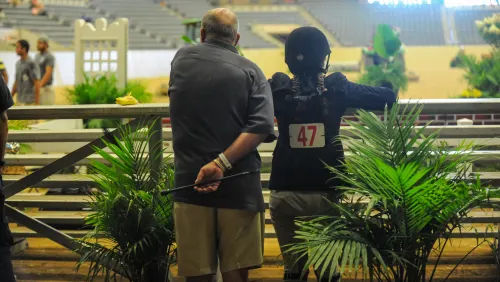It’s time for us American eventers to invest in the next generation of riders. We need to create a program that helps younger riders prepare for a competitive career and for a life in and with horses.
Back when I was a youngster (about 25 years ago), the U.S. Equestrian Team had a program that targeted eventing riders and placed them with our team’s coach, Jack Le Goff, at the USET’s training center in So. Hamilton, Mass., for months, even years. Today, our federation’s high-performance division targets 30 riders each year and gives them a three-day clinic with one of our top riders.
I know that’s how it works, because I was that clinician for a while. Kim Severson has succeeded me in that post and is doing a great job, but is it enough?
We have to decide what we’re trying to get out of this program. Are we expecting one or more of those riders to compete for the United States (especially in a championship) within the following few years, or are we expecting the program to help riders with their total horsemanship so that, eventually, they can rise to the level that we need for them to represent us internationally?
There are arguments for both sides. One side says that we should expect the riders to prepare themselves for their careers or for international competition, and that argument adds these are the riders that we want on a team because they’re self-driven and make things happen. The other side says that some simply don’t have that opportunity, and we must get the right message out there for them to follow.
In the time I spent training with Jack, we covered the theory of all aspects of horses and stable management, and we practiced, practiced and practiced dressage, jumping and galloping cross-country. We had lectures, video sessions and lots of time in the saddle. I may be turning into a person who looks back and says, “Back when I did it.” But, realistically, this kind of training isn’t happening anywhere in this country. Some programs do this privately, but these programs are expensive for riders, and I know that many potential good riders cannot afford to be in high-dollar programs like that.
Competition is what attracts all of us who want to be top riders–it’s the exciting part. But, too often, people want to compete before they’ve really learned how to ride–or how to train and condition the horses they compete. Should a program be designed to teach people how to ride, or should it be targeted toward just the competition side? Right now, our program is certainly competition-oriented, and I really believe that we’re missing a huge part of the deal.
You know, 20 years ago the riders who were winning our biggest competitions and were on our teams were generally much younger than they are today. Most, not all, medals were won by people in their 20s, with a few in their early 30s. Now most medals are won by people in their 30s, with quite a few in their 40s.
ADVERTISEMENT
Is this because the game is harder and it takes more time to learn? Or are we missing an educational piece that only allows people to learn how to ride by experience, a much longer road to travel? I really don’t think we’re paying enough attention to the education side.
The U.S. Eventing Association started the instructor certification program (in which I’ve participated) a few years ago for the gen-eral eventing teacher, and now we need to move this level of thinking to the high-performance level.
So I think that we need to invest some money into a broader-based educational program, although it should be a program with at least some of our elite, high-performance riders. At the minimum, promising, younger riders should be placed with top professionals for a long time, at minimum a year or so. Each year, we should have several training sessions of more than just a few days, and then we should pick the top class of these riders and pay for their further education with these top professionals.
I know this all comes down to money, but programs that are truly beneficial can and do find ways to finance themselves, one way or another. Granted, there would have to be markers that these riders would have to meet along the way to make sure that the money is being spent well.
The dressage and show jumping groups have developing-rider programs that are working rather well. The jumpers spend quite a lot of money on developing-rider tours, and this has really paid off in these past few years in creating a depth of talent. The jumping team’s success on the Samsung Super League Tour last year was the result of putting more riders on the teams than any other country.
The dressage group has realized that they need to develop a base for their team, and they’ve put together, by staff and volunteers, a program that will in the near future help produce a variety of riders who will be our next “players.”
Now we eventers have to solve this puzzle of how to encourage and develop riders, trainers and horsemen for the future. If we believe that playing on the international stage (including the Olympics) is important to our sport, then we must invest enough time, energy and money to give ourselves the best chance of putting true champions on that stage.














